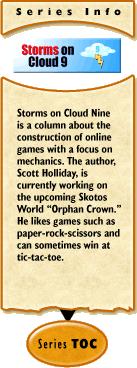 Storms on Cloud 9 #20:
Storms on Cloud 9 #20:
Literally, Your Two Cents
by Scott Holliday
2003-10-03
A stray comment I made about the fate of small MMORPGs led me to do some investigating. Last time around, I mentioned that many of today's and tomorrow's games will successfully reach release and publication, but only find small populations. My question then was what population size is necessary to sustain a game?
First considerations, you will be spending a good chunk on server and bandwidth. Likewise, you might still be paying back your investors. Other costs will also eat up a good deal of your game's income. So how much is left to pay for new content? You better have something or the game is going to be left static and eventually dead. No new territory. No improvements. No excitement.
And I left out one critical factor - customer support. As a player in a large scale MMORPG, you probably expect to be able to get in-game support 24/7. So, I'll do some quick math...
Assume you pay $15 per month (as a nice round number)
24 hours a day, ~ 30 days per month = $15 for 720 hours
$15 / 720hours = $ 0.02083333 / hour
Literally, two cents per hour?
Two cents per player, per hour. Before taking out for the server, bandwidth, the building and other operating costs. So assuming all of that was ZERO, how many players do you need to support customer support?
Assuming you're paying them at all...
Let's say, minimum wage, no benefits...
~ $5.15 / 0.02083333 = 247 paying players?
And that's without considering other costs. My guess is that in most situations it will take twice that or more. Thinking about other industries, now you know why support can be so hard to reach. Or, for those who actually work tech support somewhere, now you know why you have a headache when you go home.
I imagine you are now thinking of online games you know that have less than that number of players. Yep. So how do they do it?
- Free Labor: Somebody is working for free. Maybe the developers. Maybe volunteers from the community. In most cases, this can be a very good thing. Either way, you have direct involvement from the people who care the most that their game succeeds. Of course, the downside comes when they burn out...
- Off Shifts: How many players are there at 5 in the morning? If you can't afford support, then you try to make the most people happy with what you are capable of.
- Good Code: Fewer errors means less time wasted jury-rigging fixes. The dream is to have your support actually supporting the game, not the errors.
- Do Support Right: Shannon has already written an excellent piece,Ten Rules of Customer Support in TT&T. I really can't say anything more.
- Veterans: Often the players who need the most help are those who have just entered the game. One of the great things about Skotos is how veteran players will often try to help out at the source. For those building a community from scratch, perhaps one of the most important points is a game design which encourages this help process.
- Dynamics: Assuming you have handled support, the next step is probably to make new content. However, as above, the more you let the players do, the more gets done. Encourage your builders. Imagine an online world where the majority of the content is created by the players. There have been some examples of this already - I'm thinking of TSO and There, but I bet there are even better examples. Now take that one more step and imagine plopping creative tools into more traditional games. Consider a fantasy world where players can build their own dungeons and stock them accordingly. How much time does it take you to build a dungeon? How much time does it take to instead build a dungeon creator's toolset?

